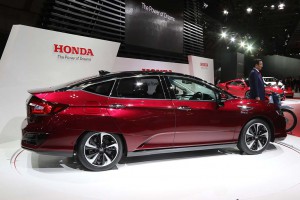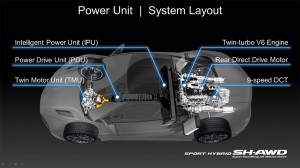
The new Honda Clarity will soon offer a plug-in hybrid and pure battery option, along with the hydrogen-powered version soon going on sale.
Honda has become the latest automaker to launch a fuel-cell vehicle on the U.S. retail market, unveiling the production version of the Clarity hydrogen car at the L.A. Auto Show on Wednesday.
But the project is creating a bit of confusion because Clarity is more than just a hydrogen car. It is actually a flexible platform that will eventually be used for a wide variety of alternative-power vehicles, including a plug-in and a pure battery-electric vehicle, or BEV, American Honda chief John Mendel told TheDetroitBureau.com.
Clarity “will be the platform for at least two” other clean models, Mendel explained during an L.A. interview, adding “It will be another pillar for us,” allowing Honda to expand its alternative offerings “in a more mainstream way.”
The Japanese carmaker is offering only some hints of what’s in store, but it is expected to add a plug-in hybrid version of the Clarity in 2018, with an all-electric BEV model to follow soon afterwards.
“Fundamentally, at their core, they are all electric vehicles,” including the new Clarity Fuel-Cell Vehicle, said Mendel.
(For more on Honda’s hydrogen plans, Click Here.)

The Clarity plug-in could borrow some of its technology from the system being used in the new Acura NSX.
The hydrogen car is powered by a device called a “stack, which combines the lightweight gas with oxygen to create a flow of current. In turn, that can be used to run the same electric motors that would be used in a pure battery-powered version of the Clarity. The only emission created by a fuel-cell stack is water vapor.
When the hydrogen version of the Clarity goes on sale next year, Honda will become the third automaker to have a fuel-cell vehicle on the retail market, along with Toyota and Hyundai. Other makers, including General Motors and Daimler AG, are exploring their own, broad retail opportunities.
(Chevy teams up with US Army to test hydrogen-powered Colorado pickup. Click Here for more.)
The big challenge is the lack of a refueling infrastructure. There currently are only about a dozen stations in the U.S., most in Southern California, though the Golden State has set aside funds to put in about 100 pumps by decade’s end. Citing a state study, Mendel said it’s expected 68 stations in the Southern California region alone could support up to 10,000 hydrogen cars.
Not everyone is sold on fuel-cell technology, however. Elon Musk, the outspoken founder and CEO of battery carmaker Tesla Motors, has dubbed them “fool cells,” and even some environmentalists question hydrogen technology’s long-term potential.
That’s why Honda is trying to cover all its bases. The Clarity platform will allow it to market two other leading alternatives to the traditional internal combustion engine.
Honda has not said what form it will take with the Clarity plug-in hybrid model. There are two subtly different approaches. One pairs a downsized gas engine with electric motors. The vehicle can run on one or the other source of power – or use both to power its wheels simultaneously. That’s the method used in models such as the Toyota Prius Plug-in.
The alternative, also known as an “extended-range electric vehicle,” only uses electric motors to turn its wheels. When its batteries are depleted, a gas engine fires up but only to serve as an onboard generator. That is the approach taken with the newly updated Chevrolet Volt.
As for the pure battery-powered Honda Clarity, Mendel hinted that we can expect to see it offer longer range than current electric vehicles. Most of those models now on the market are limited to around 100 miles or less between charges.
The exception is the Tesla Model S. Along with the Model X battery SUV just coming to market, it can get nearly 300 miles with an optional, long-range battery pack. Chevrolet, meanwhile, is finishing development on the new Chevrolet Bolt which is expected to deliver 200 miles per charge when it reaches market next year. And Audi is promising a 300-mile SUV for 2018 based on the e-tron concept being shown in L.A.
While he wouldn’t discuss details, Ryan Harty, Honda’s manager of environmental business, cautioned that the maker has to balance issues like weight, passenger space, cost and consumer needs when determining where to go with the Clarity BEV model. The between-the-lines message is that range will likely be closer to that of the Chevy Bolt than the Tesla Model S.
The bottom line for Honda, however, is that all three versions of the Clarity will be “a real car people will want to buy,” said Mendel.
Officials with Audi have said they hope their own battery-based models, such as that electric SUV, will represent as much as a quarter of their sales within a decade. As for Honda, “It’s not conceivable for electrified vehicles to constitute that (share) by 2025,” said Mendel.
(Click Here for complete coverage of the 2015 LA Auto Show.)
